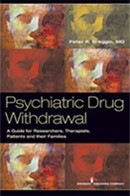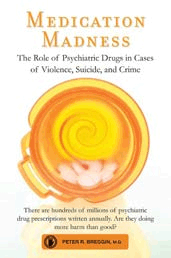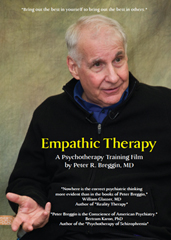Attempted Murder Charges Dropped due to Medication Toxicity
By Peter R. Breggin, MD
April 10, 2016 In my experience as a medical expert, judges and prosecutors are becoming more familiar with and responsive to the mounting scientific evidence concerning medication-induced violence. Based on my scientific report, an older man in California recently went from near certainty of spending the rest of his life in prison to immediate release into a rehabilitation and intensive nursing facility. With no further jail time, he will be going home from the health facility in a year or less, depending upon his physical recovery. I got the good news as I was preparing to fly to California to testify on his behalf less than a week ago.
A Case of Polydrug Delirium
Mr. John D., a 72 year old husband and grandfather with no history of violence, was taking multiple medical drugs as well as the older antidepressant nortriptyline when he abruptly struck his wife with a meat cleaver. She was sitting unaware of his presence, when she looked up, saw him standing there, bewildered with the cleaver in his hand, and felt blood trickling down the side of her neck. When she showed him the wound, he said he had better call 911. She tried to stop him, hoping she could staunch the bleeding herself, and believing that his medications had caused his behavior. Mr. D. was taking a variety of medications used to treat high blood pressure, diabetes, and bladder problems, as well as the nortriptyline. At least eight of the drugs have known negative effects on the brain and mind, and he had begun hallucinating for the first time a few weeks earlier.
Mr. D.’s Wife Wanted Him Released
Despite her attempt to stop her husband, he called 911, and the police took him to jail. His wife required stitches but quickly recovered. She wrote two documents for the police both stating that she believed that the drugs had caused his assault and that she wanted him to come home. Instead, the state’s attorney charged him with attempted murder, which would have kept him in jail well past his life expectancy, were he to be found guilty. He physically and cognitively declined in jail for ten months awaiting trial while the state continued with its uncompromising plan to try him for attempted murder.
A Last Resort
When Mr. D.’s attorney, Allen Petroff, came upon my work in December, 2015, he felt I was a “last resort,” and his client’s only hope of not “dying in jail.” When Mr. Petroff informed the judge and the state’s attorney that he was seeking an involuntary intoxication defense, they were at first incredulous.
My Report in the Case
When I read the medical records and police reports, the case for an involuntary intoxication turned out to be very strong. I wrote a 37-page single spaced report. Here is the introduction to my redacted report, which is also attached in full:
At the time of the alleged assault, Mr. John D. [an alias] (born 1.23.43) was a 73-year old man with no history of violence or criminal activities. Reportedly, he hit his wife with a cleaver. At the time he had diabetes, an old myocardial infarction (heart attack), and other medical disorders, and was on multiple medications with adverse psychoactive effects, with critical decreases and increases in dosage leading up to the alleged offense of assaulting his wife on 5.31.15.
Mr. John D. is charged with attempted murder. His wife, Mrs. John D., is supportive of him and refused to press charges in the belief that his action were caused by the adverse effects of his multiple medications. She describes her husband as growing increasingly agitated, irritable, angry, suspicious and delusional over a several month period. His condition dramatically worsened after additional medication changes on his 4.15.15 visit to the doctor. After that visit, he developed his first hallucinations. At the last visit to his physician with his wife one month later on 5.14.15, his wife reported her husband’s hallucinations. Additional medication changes were made and seventeen days afterward on 5.31.15, he committed the unprecedented, unprovoked, bizarre assault on his wife.
I have been asked to evaluate the case for the potential role of medication and/or other factors in causing or contributing to his actions on 5.31.15 My review of the records indicates that, at the time of the assault, Mr. John D. suffered from a medication-induced confusional state with delirium and psychosis (hallucinations), which acutely disrupted his conscious control over his behavior, as well as his memory for the events. People in this condition can become extremely irritable and dangerous, since their impulses are no longer under conscious control.
Mr. John D. did not suffer from a “mental illness” with all the controversy concerning the diagnosis of mental illnesses and the complexity of evaluating the capacity for conscious, responsible action when suffering from them. Medication-induced confusional states with delirium and psychosis are well-documented, often acute (short-lived) neurological disorders of the brain that by definition, disrupt consciousness, self-awareness, personal responsibility, and self-control. In this case, the probability of Mr. John D. enduring such an involuntary intoxication was greatly increased by multiple factors including polydrug treatment with multiple medications known to cause this kind of brain dysfunction, age, infirmity, and improper medical evaluation and treatment for his developing confusional state with delirium and psychosis.
A Stroke of Luck
The antidepressant in this case, nortriptyline, is not as commonly associated with violence as the newer ones; but it is strongly associated with causing delirium. My opinion was that polydrug therapy caused Mr. D. to become delirious, thereby fitting the California involuntary intoxication criteria for being “unconscious” yet “awake” during the perpetration. Definitions of delirium usually include impaired “consciousness,” even though the person can walk, talk, and take actions. In order to show that nortriptyline is especially prone to cause delirium, I decided to trace how far back in time delirium had been a known reaction to the older antidepressant. By a stroke of good fortune, I found the first FDA-approved summary for nortriptyline in my large collection of annual Physicians’ Desk References. The year of the volume was 1967 and, as if by a miracle, inside the book those decades ago I had tucked a special Supplement about the drug that I had received in the mail from the drug company. It showed that 6% of nearly 2,000 patients suffered from a confusional state (delirium). Most cases were classified as severe and caused disorientation in older people.
The Conclusion of the Case
Defense attorney Petroff spent considerable time talking with me about the complexities of the case and my report. He then spent additional time talking with the state’s attorney and the judge right up to the moment I was ready to fly to the trial in California.
Convinced by the report and the defense attorney’s explanation of it, the state’s attorney took a much more lenient approach. Within less than a week, Mr. D. was released from jail to be admitted into the rehabilitation and skilled nursing care facility. The first-degree murder charges were dropped and Mr. D. pled to a much lesser charge that required no further time served in jail. Mr. John D. will be under state supervision for one year, but the state can authorize his return home sooner when his physical condition improves.
Attorney Petroff, who had contacted me in desperation, called the result a “miracle.” He wrote:
Particularly helpful to my client’s case was Dr. Breggin’s swift pace while retaining an incredibly thorough attention to detail. Due to some scheduling failures on my part, Dr. Breggin received the voluminous medical and prescription records with less than two weeks to draft and compile a report. Not only did Dr. Breggin rise to the challenge but his inquiries lead to additional materials being subpoenaed that had not previously occurred to me. Moreover, he reduced his rate to ensure my client would be able to afford his testimony if necessary.
Dr. Breggin’s influence in my client’s case was immeasurable. His patience explaining his opinions allowed me to articulate them clearly to the prosecutor and then again to his supervisor in what would be the negotiation that ultimately settled the case. His report’s thoroughness, particularly his numerous references to scientific and medical authority, gave his opinions an unquestionable credibility that forced the District Attorney to reevaluate the case and revise their offer. Because of Dr. Breggin my client will receive the care and medication changes he needs rather than being forced to endure a sentence that would re-victimize his spouse and ensure his death in prison.
This was an unusually good outcome for a criminal case. In addition to the hard work put into the case by attorney Petroff and the willingness of the state to respond to my scientific report, it had a broad array of good facts to support my opinion. These facts included his wife’s desire not to prosecute him, his nonviolent history, the numerous psychoactive drugs he was taking, his medically frail and elderly condition, the development of hallucinations starting a few weeks earlier, and the prescription mistakes made by his physician.
Read Dr. Breggin’s complete report in the case of Mr. John D.





